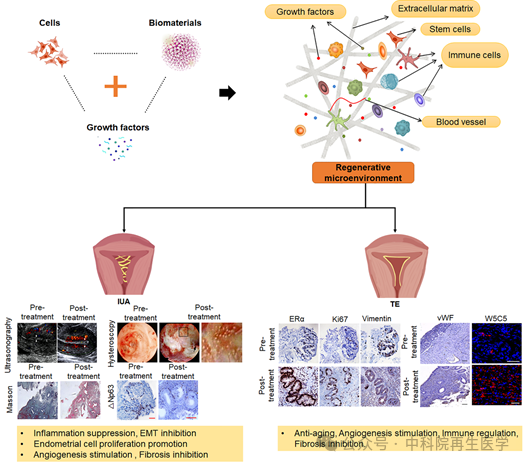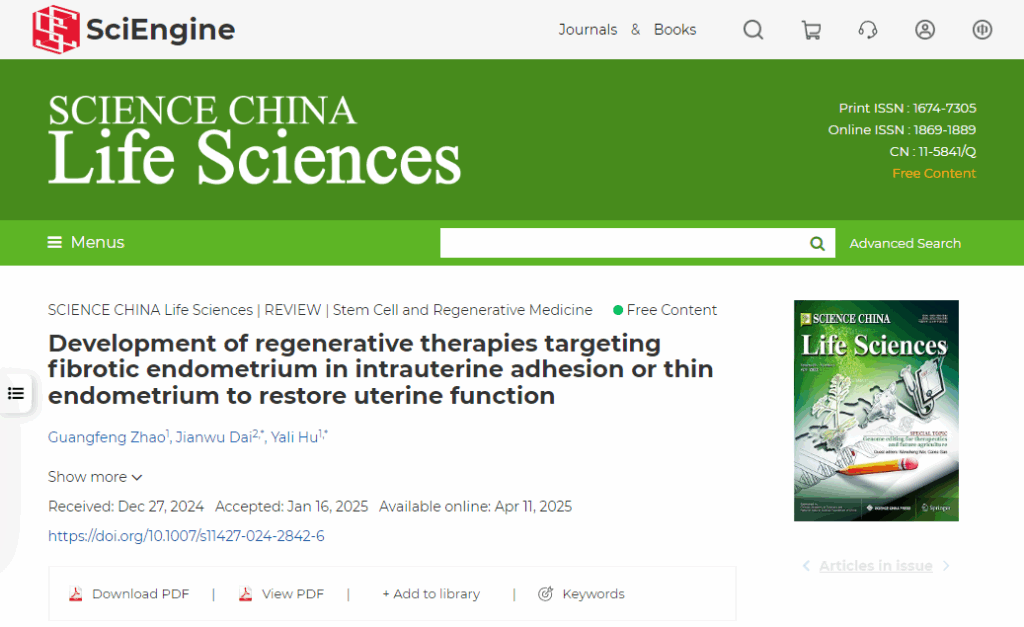The research results not only improve the understanding of the pathomechanisms of IUA and TE, but also provide strong support for the development of novel therapeutic approaches based on regenerative medicine.
Intrauterine adhesions (IUA) and thin endometrium (TE), as major challenges in the field of female reproduction, not only seriously affect women’s fertility, but also show a high prevalence among female infertility patients. Traditional treatments (e.g., hysteroscopic adhesion detachment and estrogen therapy) have obvious limitations in clinical application, and breakthroughs in regenerative medicine have opened up a whole new path to overcome this challenge.
It is noteworthy that under the continuous support of national research programs such as the Strategic Science and Technology Pilot Program of the Chinese Academy of Sciences (CAS), regenerative medicine technology system based on stem cell therapy, biomaterials support and other innovative means has made key progress, which provides scientific basis and technical support for restoring the regenerative potential and fertility of patients’ uterus through the mechanisms of regulating the microenvironment of uterus endometrium and reconstructing the structure of the functional layer.
Background of the study
Prof. Yali Hu’s team at Nanjing Gulou Hospital and researcher Jianwu Dai at the Institute of Genetics and Developmental Biology, Chinese Academy of Sciences reviewed the application of stem cell therapy and biomaterial-supported therapy in endometrial regeneration therapy and their molecular mechanisms.
Stem cell therapy shows great potential in the treatment of IUA and TE, and can significantly promote endometrial regeneration through transplantation of mesenchymal stem cells (MSCs) from different sources, such as bone marrow mesenchymal stem cells (BMSCs) and umbilical cord mesenchymal stem cells (UC-MSCs). The research team has pioneered international research on stem cell therapy-based treatments for IUA and TE, and has achieved remarkable results. For example, the first randomized controlled clinical study completed by the team showed that endometrial regeneration of patients with IUA could be significantly promoted by transplantation of autologous BMSCs with collagen scaffolding complexes, which improved the pregnancy success rate and the rate of live births.
Biomaterials such as collagen, as a carrier for stem cell transplantation, effectively support the survival and secretory function of transplanted cells and promote endometrial repair. Collagen has good biocompatibility and mechanical properties, which can provide physical support and a microenvironment for cell growth for endometrial repair. The research team independently developed a new biodegradable bioscaffold material, which can precisely control the growth, secretion and release of stem cells, further improving the therapeutic effect.
The in-depth study of the molecular mechanisms of IUA and TE provides the basis for the development of targeted therapies. It has been found that key processes such as inflammation, epithelial-mesenchymal transition (EMT), and cellular senescence play an important role in the pathogenesis of IUA and TE. Through single-cell sequencing and other technical means, the research team has revealed the abnormal changes of immune cells, epithelial cells, mesenchymal cells, and other cell types in the endometrium of patients with IUA and TE, which provides a theoretical basis for the development of new therapies.

Figure Improving the endometrial microenvironment through regenerative medicine strategies for the treatment of IUA and TE
The review also suggested that the treatment of IUA and TE still faces many challenges. Future studies should further explore the specific mechanism of stem cell action in endometrial regeneration, optimize stem cell transplantation methods and biomaterial design to improve therapeutic efficacy and safety. And further strengthen the in-depth study of the molecular mechanisms of IUA and TE, especially the regulatory mechanisms for key processes such as inflammation, EMT, and cellular senescence, to provide a theoretical basis for the development of new therapeutic targets. In addition, with the development of emerging technologies such as gene editing, tissue engineering, and nanotechnology, it is expected that the future will bring more innovative solutions for the treatment of IUA and TE.
The review was recently published in Science China Life Sciences. The research results not only improve the understanding of the pathogenesis of IUA and TE, but also provide strong support for the development of novel therapeutic approaches based on regenerative medicine. With the advances in stem cell therapy and biomaterials technology, as well as in-depth research on molecular mechanisms, it is expected that more effective and safer therapeutic options will be available for patients with IUA and TE in the future, thereby improving their fertility.
Disclaimer: The information in this article comes from the Internet, this article is only for the purpose of knowledge exchange and sharing and popularization of science, does not involve commercial propaganda, and does not serve as relevant medical guidance or medication advice. Please contact us for deletion if there is any infringement. Source: CAS Regenerative Medicine


